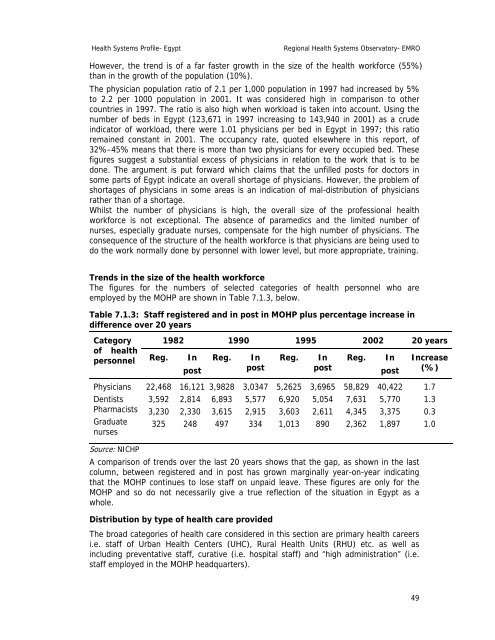Egypt : Complete Profile - What is GIS - World Health Organization
Egypt : Complete Profile - What is GIS - World Health Organization
Egypt : Complete Profile - What is GIS - World Health Organization
You also want an ePaper? Increase the reach of your titles
YUMPU automatically turns print PDFs into web optimized ePapers that Google loves.
<strong>Health</strong> Systems <strong>Profile</strong>- <strong>Egypt</strong> Regional <strong>Health</strong> Systems Observatory- EMRO<br />
However, the trend <strong>is</strong> of a far faster growth in the size of the health workforce (55%)<br />
than in the growth of the population (10%).<br />
The physician population ratio of 2.1 per 1,000 population in 1997 had increased by 5%<br />
to 2.2 per 1000 population in 2001. It was considered high in compar<strong>is</strong>on to other<br />
countries in 1997. The ratio <strong>is</strong> also high when workload <strong>is</strong> taken into account. Using the<br />
number of beds in <strong>Egypt</strong> (123,671 in 1997 increasing to 143,940 in 2001) as a crude<br />
indicator of workload, there were 1.01 physicians per bed in <strong>Egypt</strong> in 1997; th<strong>is</strong> ratio<br />
remained constant in 2001. The occupancy rate, quoted elsewhere in th<strong>is</strong> report, of<br />
32%–45% means that there <strong>is</strong> more than two physicians for every occupied bed. These<br />
figures suggest a substantial excess of physicians in relation to the work that <strong>is</strong> to be<br />
done. The argument <strong>is</strong> put forward which claims that the unfilled posts for doctors in<br />
some parts of <strong>Egypt</strong> indicate an overall shortage of physicians. However, the problem of<br />
shortages of physicians in some areas <strong>is</strong> an indication of mal-d<strong>is</strong>tribution of physicians<br />
rather than of a shortage.<br />
Whilst the number of physicians <strong>is</strong> high, the overall size of the professional health<br />
workforce <strong>is</strong> not exceptional. The absence of paramedics and the limited number of<br />
nurses, especially graduate nurses, compensate for the high number of physicians. The<br />
consequence of the structure of the health workforce <strong>is</strong> that physicians are being used to<br />
do the work normally done by personnel with lower level, but more appropriate, training.<br />
Trends in the size of the health workforce<br />
The figures for the numbers of selected categories of health personnel who are<br />
employed by the MOHP are shown in Table 7.1.3, below.<br />
Table 7.1.3: Staff reg<strong>is</strong>tered and in post in MOHP plus percentage increase in<br />
difference over 20 years<br />
Category<br />
of health<br />
personnel<br />
Physicians<br />
Dent<strong>is</strong>ts<br />
Pharmac<strong>is</strong>ts<br />
Graduate<br />
nurses<br />
1982 1990 1995 2002 20 years<br />
Reg. In<br />
post<br />
22,468<br />
3,592<br />
3,230<br />
325<br />
16,121 3,9828<br />
2,814 6,893<br />
2,330 3,615<br />
248 497<br />
Reg. In<br />
post<br />
3,0347<br />
5,577<br />
2,915<br />
334<br />
Reg. In<br />
post<br />
5,2625<br />
6,920<br />
3,603<br />
1,013<br />
3,6965<br />
5,054<br />
2,611<br />
890<br />
Reg. In<br />
post<br />
58,829<br />
7,631<br />
4,345<br />
2,362<br />
40,422<br />
5,770<br />
3,375<br />
1,897<br />
Source: NICHP<br />
A compar<strong>is</strong>on of trends over the last 20 years shows that the gap, as shown in the last<br />
column, between reg<strong>is</strong>tered and in post has grown marginally year-on-year indicating<br />
that the MOHP continues to lose staff on unpaid leave. These figures are only for the<br />
MOHP and so do not necessarily give a true reflection of the situation in <strong>Egypt</strong> as a<br />
whole.<br />
D<strong>is</strong>tribution by type of health care provided<br />
The broad categories of health care considered in th<strong>is</strong> section are primary health careers<br />
i.e. staff of Urban <strong>Health</strong> Centers (UHC), Rural <strong>Health</strong> Units (RHU) etc. as well as<br />
including preventative staff, curative (i.e. hospital staff) and “high admin<strong>is</strong>tration” (i.e.<br />
staff employed in the MOHP headquarters).<br />
Increase<br />
(%)<br />
49<br />
1.7<br />
1.3<br />
0.3<br />
1.0

















